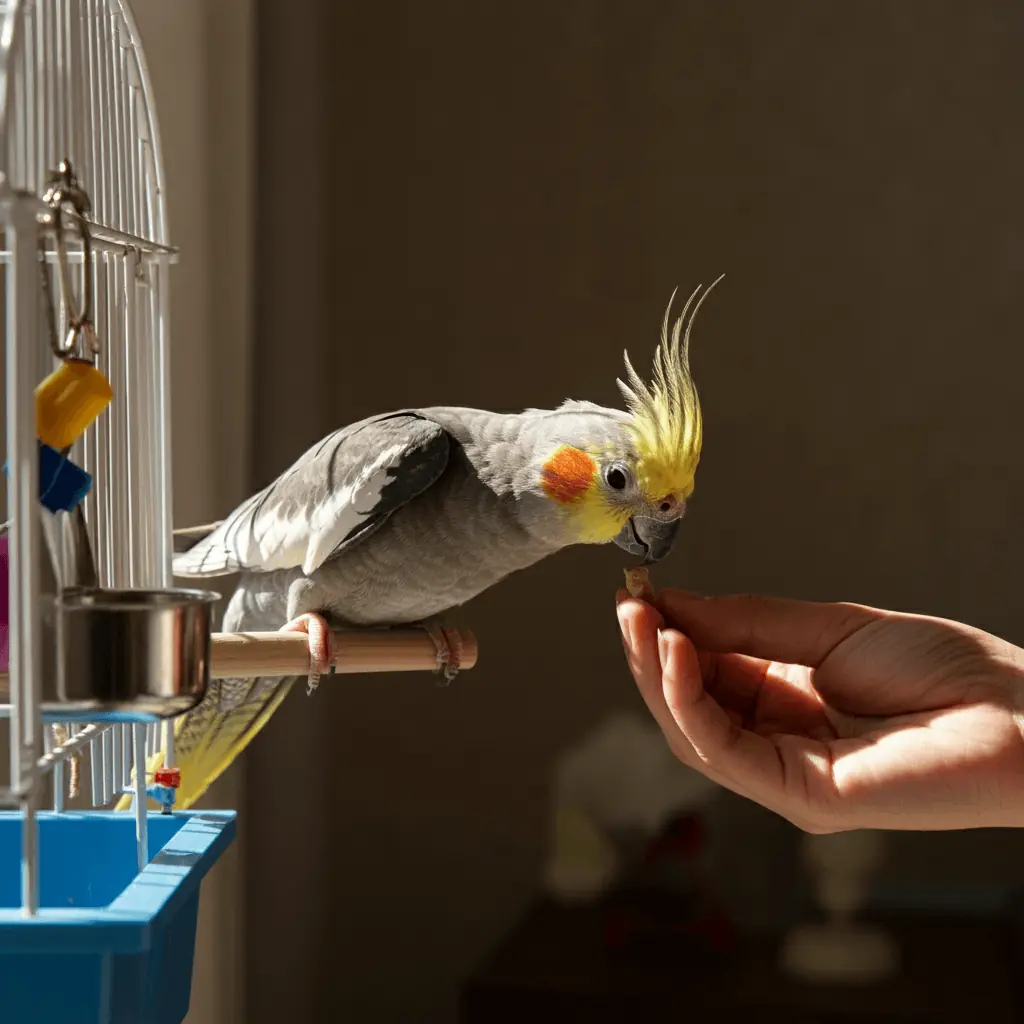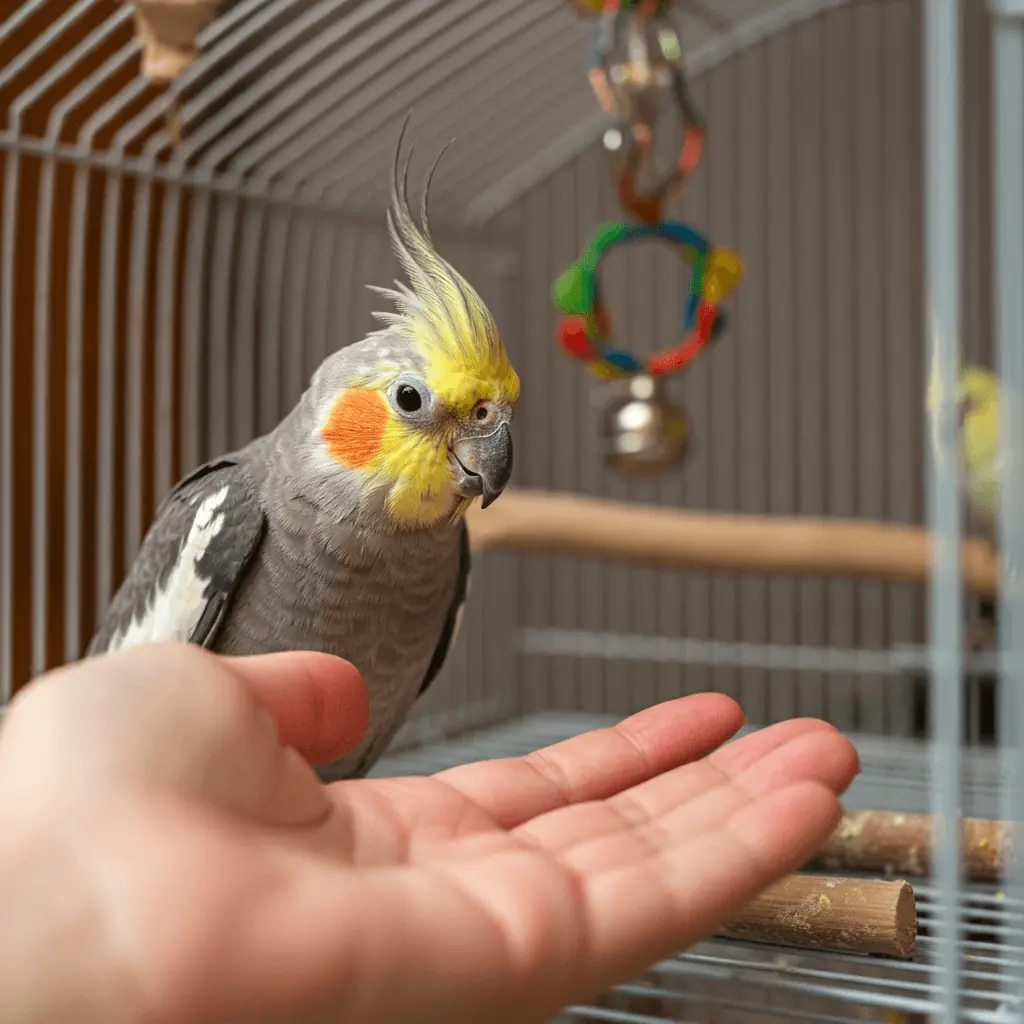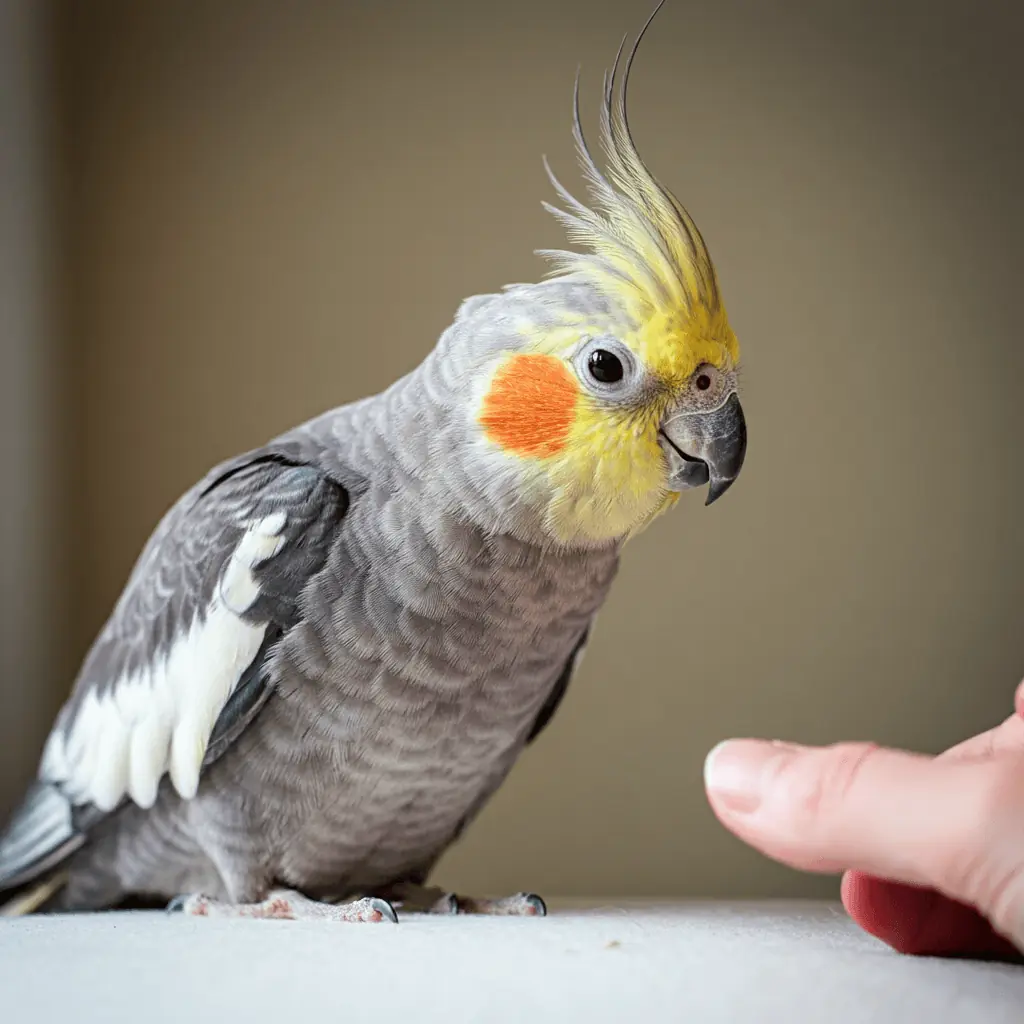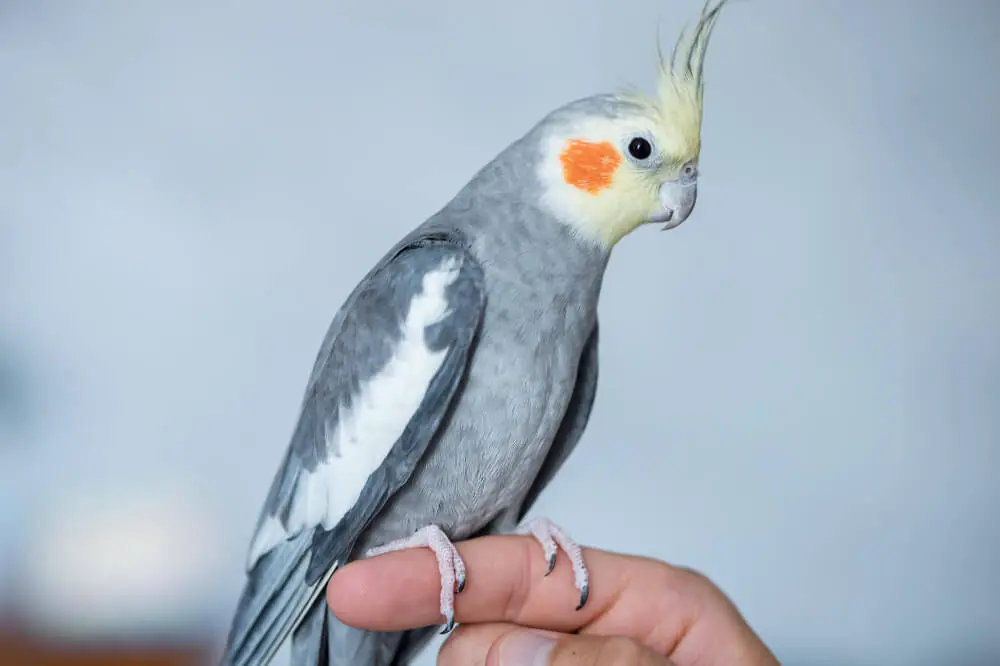Introduction
Hand-taming your cockatiel is one of the most rewarding experiences for bird owners. While cockatiels are naturally social and curious, they can be a bit timid when it comes to human interaction. The good news is, with patience and the right approach, you can easily build trust and create a lasting bond with your feathered friend.
In this step-by-step guide, we’ll cover everything you need to know to hand-tame your cockatiel, from understanding their behavior to getting them comfortable with your presence. Whether you’re a first-time bird owner or just looking to strengthen your relationship with your cockatiel, these simple tips will help you create a strong bond.
Hand-taming isn’t just about teaching your bird to step onto your hand — it’s about helping your cockatiel feel safe and confident around you. By following the steps outlined in this guide, you’ll learn how to train your cockatiel to be friendly, make it feel comfortable, and even enjoy the bonding process.
With the right cockatiel training tips and a little patience, you’ll soon find your bird looking forward to spending time with you. So, let’s dive in and explore how to tame a cockatiel in a way that’s effective and enjoyable for both of you.
Why Hand-Taming Your Cockatiel Is Important
Hand-taming your cockatiel is not only about teaching them tricks or getting them to step onto your hand. It’s about building trust and forming a deeper connection with your bird. Cockatiels are social animals, and when they trust you, they feel more secure and comfortable in their environment.
Taming your cockatiel can also make everyday activities, like cleaning their cage or taking them to the vet, less stressful for both you and your bird. A well-tamed cockatiel will be easier to handle, less prone to biting, and more willing to interact with other people, making them a wonderful companion.
Additionally, by taking the time to hand-tame your bird, you’re enhancing their quality of life. Birds that are comfortable with their owners often experience less stress and anxiety, leading to better overall health and happiness. If you’re looking to strengthen the bond between you and your feathered friend, taming is the key.

This cockatiel shows ease around humans, a crucial step in the hand-taming process.
Understanding Your Cockatiel’s Behavior
Before you begin the taming process, it’s important to understand your cockatiel’s natural behavior. Cockatiels are highly observant, cautious birds by nature. They often take time to warm up to new people or environments. By observing their body language, you can better understand when they feel comfortable or stressed.
For example, a relaxed cockatiel may fluff up its feathers, chirp softly, or even preen. On the other hand, signs of discomfort or fear include raised feathers, hissing, or backing away. Learning to recognize these behaviors will help you gauge your cockatiel’s readiness for interaction and training.
Additionally, cockatiels are creatures of habit. They feel safest when their routine is consistent. Sudden changes in their environment or routine can make them more nervous, so it’s best to approach taming at a steady pace. By respecting your bird’s boundaries and watching for signs of comfort, you’ll set the foundation for successful hand-taming.

Notice the relaxed posture of the cockatiel, indicating its comfort and trust.
Step 1: Building Trust with Your Cockatiel
The first and most important step in hand-taming your cockatiel is building trust. Without trust, your bird will be too fearful to engage with you. Start by simply being present around your cockatiel’s cage. Sit nearby, talk to them in a calm and soothing voice, and allow them to get used to your presence without making any sudden movements.
This initial stage can take some time, especially if your cockatiel is shy or has had little human interaction before. Remember, every bird is different. Some cockatiels may warm up to you quickly, while others will need more time. The key here is patience and consistency. Spend a few minutes each day sitting near your bird, making sure they see you as a non-threatening part of their environment.
Avoid rushing the process. The goal is to let your cockatiel feel safe in your presence before you move on to more direct interactions. Once your bird starts acting relaxed when you’re around—eating, grooming, or even approaching the side of the cage near you—it’s a sign that they’re beginning to trust you.
Step 2: Getting Your Cockatiel Comfortable with Your Presence
Once your cockatiel starts to feel more at ease with you around, the next step is to get them comfortable with your closer presence. This means slowly moving closer to the cage while maintaining a calm, relaxed demeanor. Talk softly to your bird, allowing them to hear your voice and associate it with positive, non-threatening experiences.
At this stage, you want to begin creating a positive association between yourself and your cockatiel. Offer them their favorite treat through the bars of the cage, but don’t try to touch them just yet. Let them come to you on their own terms. The goal here is for your bird to start recognizing your hand as something friendly, not scary.
If your cockatiel seems hesitant, that’s perfectly normal. Give them the space they need and keep your movements slow and predictable. Over time, they’ll start to become more curious about you and may even come closer to investigate. When they start accepting treats from your hand without hesitation, you’ll know that they’re becoming comfortable with your presence.

A cockatiel receives a treat directly from a hand, a significant trust-building exercise.
Step 3: Offering Treats to Encourage Interaction
Now that your cockatiel is getting used to you being nearby, it’s time to encourage more direct interaction using treats. Cockatiels are food-motivated, and offering their favorite treats is an excellent way to build trust and strengthen the bond. Choose healthy options like millet spray, small pieces of fruit, or seeds that your bird particularly enjoys.
Start by offering the treat through the cage bars, allowing your bird to take it from your hand. Be patient—if they don’t take the treat right away, simply wait and try again later. The key is consistency. Over time, your cockatiel will learn that your hand means something positive (yummy treats!) and will begin associating you with good things.
As your bird becomes more comfortable, you can begin placing your hand inside the cage while holding the treat. Keep your hand still and let your cockatiel approach at their own pace. Never force them to interact or rush the process, as this could cause stress. Eventually, your bird will begin coming to you willingly, eager for their treat.
Offering treats is not just about taming—it’s about building trust through positive reinforcement. This step lays the foundation for the more hands-on taming that will come next.
Step 4: Introducing Your Hand to the Cockatiel’s Cage
With your cockatiel now more comfortable around you and willing to take treats, it’s time to introduce your hand inside the cage. This step is crucial as it’s the beginning of more direct physical interaction. Start slowly by placing your hand gently inside the cage, holding a treat, and keeping your movements calm and controlled.
At first, your cockatiel might be hesitant or even nervous about your hand being in their space. Don’t force interaction—let them get used to your hand being there without any pressure to approach. The goal is to show your bird that your hand is a safe and friendly presence.
You can begin by holding the treat close to them, but not too close, giving them the choice to approach if they feel comfortable. Be patient and allow them to explore your hand on their own terms. This process can take some time, and it’s important to remain calm even if your cockatiel doesn’t respond immediately.
Over time, as your cockatiel gets more comfortable, they’ll start associating your hand with positive experiences. Once they regularly take treats from your hand inside the cage, you’re well on your way to the next step of hand-taming.

Gently introducing a hand into the cockatiel’s cage to start the taming process.
Step 5: Encouraging Your Cockatiel to Step Onto Your Hand
Now that your cockatiel is comfortable with your hand inside their cage, the next step is to gently encourage them to step onto your hand. This is a key moment in hand-taming, as it signifies trust and comfort between you and your bird.
Start by offering a treat in one hand, and with your other hand, gently place it near your cockatiel’s feet. Hold the treat close enough that they have to move towards it to take a bite. As your cockatiel reaches for the treat, you can say a simple command like “step up” to associate the action with the verbal cue.
If your bird hesitates, don’t rush or push them. Stay calm and patient. Cockatiels may need several attempts before they feel safe enough to step onto your hand. The key here is to be consistent—repeating this process over several days, allowing your cockatiel to feel in control of the interaction.
Once your bird steps onto your hand, make sure to offer plenty of praise and their favorite treat as positive reinforcement. Gradually, your cockatiel will become more comfortable stepping up, and you can even start moving your hand slightly while they’re on it, helping them adjust to being handled.

Capturing the moment a cockatiel steps onto a human hand, marking a training success.
Step 6: Reinforcing Positive Behavior with Rewards
Reinforcing positive behavior is a crucial aspect of successfully hand-taming your cockatiel. Birds, like many other animals, respond well to positive reinforcement. Each time your cockatiel steps onto your hand, accepts a treat, or engages with you calmly, it’s important to reward them immediately with their favorite snack or verbal praise.
The key to positive reinforcement is timing—make sure you give the reward as soon as they perform the desired behavior. This helps your cockatiel clearly associate the action with the reward, making them more likely to repeat the behavior in the future.
While treats are a great motivator, verbal praise or a gentle scratch can also be effective, especially as your bird grows more comfortable with handling. Use an encouraging tone, and stay consistent with your rewards to strengthen the trust and bond between you and your bird.
Over time, as your cockatiel becomes more confident, you can begin reducing the frequency of treats, replacing them with verbal praise or physical affection. This will help your cockatiel learn to enjoy being handled without always expecting food, which is important for long-term taming success.
Step 7: Patience and Consistency in the Training Process
Patience and consistency are the cornerstones of successfully hand-taming your cockatiel. Every bird is different, and some may take longer to feel comfortable and trust you than others. It’s important to remember that building this trust is a gradual process and cannot be rushed.
Consistency means spending time with your cockatiel every day, even if it’s just for a few minutes. Regular interaction helps your bird become more familiar with you and reinforces the taming lessons you’ve already worked on. Whether it’s sitting by their cage, offering treats, or encouraging them to step up, daily engagement is crucial.
Patience, on the other hand, is essential when setbacks occur. Some days, your cockatiel may seem more reluctant or fearful, and that’s okay. Avoid forcing interactions, as this can damage the trust you’ve worked so hard to build. Take a step back when necessary, and let your bird set the pace.
The key is to stay calm, positive, and consistent. Over time, with patience and routine, your cockatiel will become hand-tamed and form a lasting bond with you.
Common Challenges When Hand-Taming a Cockatiel
Hand-taming a cockatiel can be a rewarding experience, but it’s not without its challenges. Understanding potential setbacks will help you stay patient and positive throughout the process.
1. Fear or Timidity
Some cockatiels may be naturally more fearful or timid, especially if they haven’t been exposed to much human interaction before. In these cases, building trust takes longer, and you may need to spend more time just getting your bird comfortable with your presence before moving on to direct interaction.
2. Biting
Cockatiels can bite when they feel scared or threatened. If your bird bites, don’t react with anger or loud noises, as this can reinforce their fear. Instead, gently remove your hand and try again later. Biting is often a sign that you need to slow down and allow your bird more time to feel safe.
3. Inconsistent Progress
Some days, your cockatiel may seem to be making great progress, while on other days they might regress. This inconsistency can be frustrating, but it’s a normal part of the process. Just keep working with them, and over time, you’ll notice a steady improvement.
4. Distractions
Cockatiels are curious birds and can easily become distracted by their surroundings. If your bird seems disinterested or distracted during training sessions, try moving to a quieter area where there are fewer things to grab their attention. This will help them focus more on interacting with you.
5. Loss of Interest in Treats
If your bird stops responding to treats, it could be because they’re no longer hungry or the treats have lost their appeal. Try varying the rewards you offer to keep things exciting and ensure your bird remains motivated.
By staying aware of these common challenges, you’ll be better equipped to overcome them and keep your training sessions positive and effective.

Identifying signs of fear or discomfort in a cockatiel is crucial for respectful training.
How Long Does It Take to Hand-Tame a Cockatiel?
The time it takes to hand-tame a cockatiel can vary widely depending on the bird’s personality, past experiences, and the amount of time and patience you dedicate to the process. Some cockatiels may begin to trust you within a few days, while others could take several weeks or even months to feel comfortable enough to step onto your hand.
For birds that are already used to human interaction, taming can happen relatively quickly. However, if your cockatiel is more fearful or has had limited exposure to people, the process can take longer. The key is to work at your bird’s pace and avoid rushing.
On average, with consistent daily interaction and positive reinforcement, you may start to see progress within 1 to 3 weeks. Keep in mind that even after your cockatiel is comfortable stepping onto your hand, ongoing training is essential to maintain and strengthen that bond. Every bird is different, and there’s no “one size fits all” timeline for taming.
Patience and routine are your best tools during this time. As long as you stay committed and give your cockatiel the time they need, the rewards of a well-tamed, trusting bird are worth the wait.
FAQs About Hand-Taming Your Cockatiel
1. How long should each training session last?
Training sessions should be short and positive. Ideally, each session should last around 10 to 15 minutes. Cockatiels can become easily distracted or stressed if training lasts too long. Multiple short sessions throughout the day can be more effective than one long session.
2. What treats are best for hand-taming a cockatiel?
Cockatiels love millet spray, small pieces of fruit (like apples or grapes), and seeds. It’s important to find out what your cockatiel enjoys the most, as offering their favorite treats will encourage positive behavior during training.
3. What if my cockatiel refuses to step onto my hand?
If your cockatiel is reluctant to step onto your hand, don’t force it. Keep offering treats and let them get comfortable with your hand being close by. With time, patience, and consistency, they will eventually feel safe enough to step up.
4. Can I still tame my cockatiel if they’re older?
Yes! While younger cockatiels may be more open to taming, older birds can still be tamed with patience. The key is to go slow and build trust at a pace that’s comfortable for your bird.
5. How do I stop my cockatiel from biting during training?
If your cockatiel bites, it’s usually a sign that they’re scared or feel threatened. Give them space and avoid sudden movements. Gradually build trust, and they will become less prone to biting as they grow more comfortable with you.
6. Should I cover the cage at night during the taming process?
Yes, covering your cockatiel’s cage at night helps them feel safe and secure, especially when they’re still adjusting to you. A routine where the cage is uncovered in the morning and covered at night can give them a sense of security.
7. How can I tell if my cockatiel is ready for the next step in taming?
Look for signs of comfort and curiosity. If your cockatiel is accepting treats from your hand, approaching you willingly, or showing relaxed behavior like chirping or preening near you, it’s a good sign they’re ready for the next step.
Final Thoughts on Hand-Taming Your Cockatiel
Hand-taming your cockatiel is a journey that requires patience, consistency, and a deep understanding of your bird’s unique personality. While it may take time, the bond you’ll form with your cockatiel is well worth the effort. Remember, every step of the process—from building trust to encouraging your bird to step onto your hand—brings you closer to a happy, well-socialized companion.
By focusing on positive reinforcement, moving at your cockatiel’s pace, and keeping training sessions short and positive, you’ll gradually earn your bird’s trust and build a lifelong bond. Don’t be discouraged by setbacks or slow progress; taming is a gradual process, and each small victory is a step toward success.
With the right approach, patience, and love, you’ll not only hand-tame your cockatiel but also create a trusting, joyful relationship that enriches both of your lives.

